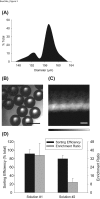Microfluidic sorting of microtissues
- PMID: 22505992
- PMCID: PMC3324260
- DOI: 10.1063/1.3692765
Microfluidic sorting of microtissues
Abstract
Increasingly, invitro culture of adherent cell types utilizes three-dimensional (3D) scaffolds or aggregate culture strategies to mimic tissue-like, microenvironmental conditions. In parallel, new flow cytometry-based technologies are emerging to accurately analyze the composition and function of these microtissues (i.e., large particles) in a non-invasive and high-throughput way. Lacking, however, is an accessible platform that can be used to effectively sort or purify large particles based on analysis parameters. Here we describe a microfluidic-based, electromechanical approach to sort large particles. Specifically, sheath-less asymmetric curving channels were employed to separate and hydrodynamically focus particles to be analyzed and subsequently sorted. This design was developed and characterized based on wall shear stress, tortuosity of the flow path, vorticity of the fluid in the channel, sorting efficiency and enrichment ratio. The large particle sorting device was capable of purifying fluorescently labelled embryoid bodies (EBs) from unlabelled EBs with an efficiency of 87.3% ± 13.5%, and enrichment ratio of 12.2 ± 8.4 (n = 8), while preserving cell viability, differentiation potential, and long-term function.
Figures




Similar articles
-
High throughput single-cell and multiple-cell micro-encapsulation.J Vis Exp. 2012 Jun 15;(64):e4096. doi: 10.3791/4096. J Vis Exp. 2012. PMID: 22733254 Free PMC article.
-
Single channel layer, single sheath-flow inlet microfluidic flow cytometer with three-dimensional hydrodynamic focusing.Lab Chip. 2012 Sep 7;12(17):3135-41. doi: 10.1039/c2lc40246g. Epub 2012 Jul 5. Lab Chip. 2012. PMID: 22763751
-
An integrated microfluidic system for reaction, high-sensitivity detection, and sorting of fluorescent cells and particles.Anal Chem. 2003 Nov 1;75(21):5767-74. doi: 10.1021/ac034568c. Anal Chem. 2003. PMID: 14588016
-
Multicellular Co-Culture in Three-Dimensional Gelatin Methacryloyl Hydrogels for Liver Tissue Engineering.Molecules. 2019 May 7;24(9):1762. doi: 10.3390/molecules24091762. Molecules. 2019. PMID: 31067670 Free PMC article.
-
Inertial microfluidic physics.Lab Chip. 2014 Aug 7;14(15):2739-61. doi: 10.1039/c4lc00128a. Epub 2014 Jun 10. Lab Chip. 2014. PMID: 24914632 Review.
Cited by
-
Image-Based Single Cell Sorting Automation in Droplet Microfluidics.Sci Rep. 2020 May 26;10(1):8736. doi: 10.1038/s41598-020-65483-2. Sci Rep. 2020. PMID: 32457421 Free PMC article.
-
Large particle multiphoton flow cytometry to purify intact embryoid bodies exhibiting enhanced potential for cardiomyocyte differentiation.Integr Biol (Camb). 2013 Jul 24;5(7):993-1003. doi: 10.1039/c3ib20286k. Epub 2013 Jun 13. Integr Biol (Camb). 2013. PMID: 23759950 Free PMC article.
-
Advances in microfluidic cell separation and manipulation.Curr Opin Chem Eng. 2013 Nov 1;2(4):398-404. doi: 10.1016/j.coche.2013.10.001. Curr Opin Chem Eng. 2013. PMID: 24701393 Free PMC article.
-
Endogenous Optical Signals Reveal Changes of Elastin and Collagen Organization During Differentiation of Mouse Embryonic Stem Cells.Tissue Eng Part C Methods. 2015 Oct;21(10):995-1004. doi: 10.1089/ten.TEC.2014.0699. Epub 2015 Jun 17. Tissue Eng Part C Methods. 2015. PMID: 25923353 Free PMC article.
-
On Chip Sorting of Stem Cell-Derived β Cell Clusters Using Traveling Surface Acoustic Waves.Langmuir. 2024 Feb 20;40(7):3453-3462. doi: 10.1021/acs.langmuir.3c02934. Epub 2024 Feb 6. Langmuir. 2024. PMID: 38318799 Free PMC article.
References
Grants and funding
LinkOut - more resources
Full Text Sources
